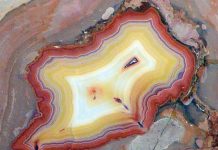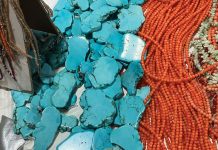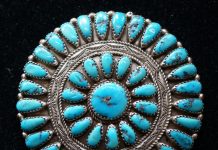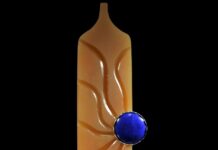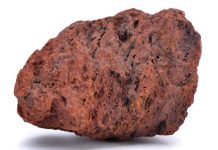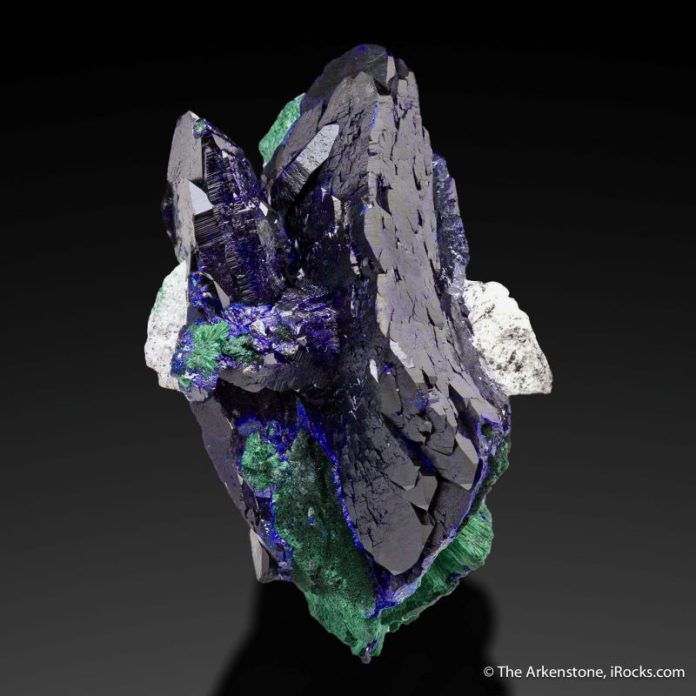
Azurite is a striking deep-blue copper carbonate mineral with the chemical formula Cu3(CO3)2(OH)2. Renowned for its vivid deep blue color, azurite derives its name from the Persian word lazhward, meaning “blue.” The intensity of its color and relative abundance make it a popular choice for collectors and lapidaries alike.

How Azurite Forms
Azurite forms in the oxidation zones of copper ore deposits when water containing carbon dioxide reacts with copper-rich minerals. This creates a secondary mineral layer that includes azurite and often its green cousin, malachite. Azurite is also one of the minerals mined to make copper metal. The two frequently occur together, as malachite forms when azurite undergoes further oxidation. It typically forms monoclinic crystals or massive, botryoidal aggregates.
Common Uses of Azurite
Historically, azurite was ground into a pigment for blue paints and dyes. However, its instability and tendency to turn green from oxidation led to its replacement by synthetic pigments. Today, azurite is primarily valued as an ore, a collector’s mineral, a semi-precious gemstone, and a tool for metaphysical practices. While relatively soft (3.5 to 4 on the Mohs scale of hardness), it is sometimes used in jewelry as cabochons or inlays.
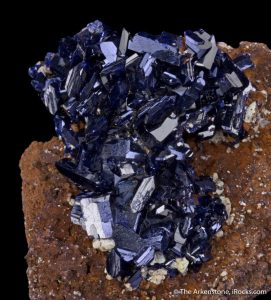
Arkenstone, iRocks.com
Top Azurite Locations Around the World
Azurite is a common mineral, occurring in around 10,000 localities worldwide. Significant deposits of azurite are found in copper-rich regions worldwide. Notable locations include:
- Morocco: The Touissit region is famous for its vibrant blue azurite crystals, often found in combination with malachite, while azurite from Mibladen is another significant source of excellent quality specimens.
- USA: Several locations in Arizona, such as the Copper Queen Mine in Bisbee and the Mammoth Mine, produce exquisite azurite specimens often in association with malachite.
- Congo (DRC): The Kipushi Mine is known for producing exceptional azurite crystals alongside other copper minerals.
- Australia: The Broken Hill mining region yields some of the finest azurite crystals, often found with other copper minerals, including native copper.
- Namibia: Perhaps some of the finest and most collectible azurite comes from the Tsumeb mine, where it often forms with malachite.
FAQs About Azurite
Q: What is azurite made of?
A: Azurite is a copper carbonate mineral with the chemical formula Cu₃(CO₃)₂(OH)₂, forming in the oxidation zones of copper ore.
Q: Is azurite rare or valuable?
A: While not extremely rare, high-quality azurite crystals—especially from notable mines like Tsumeb or Bisbee—can be valuable to collectors and jewelers.
Q: Can azurite turn green?
A: Yes. Azurite can oxidize into malachite over time, which is why some specimens show a mix of blue and green.
Q: Is azurite used in jewelry?
A: Though relatively soft, azurite is occasionally used in cabochons or inlay work due to its vivid color.
Q: What chakra is azurite associated with?
A: In metaphysical circles, azurite is linked to the third eye chakra, enhancing intuition and insight.
Azurite Metaphysical Meaning
In metaphysical circles, azurite is often called the “Stone of Heaven” for its reputed ability to enhance intuition, insight, and spiritual awareness. It is believed to open the third eye chakra, aiding in meditation and inner vision. Practitioners also associate azurite with mental clarity and creativity, using it to enhance decision-making and problem-solving.
Azurite: Final Thoughts
Azurite remains one of the most visually captivating minerals found in copper-rich regions around the world. Its vivid blue hue and crystal formations have made it a favorite among mineral collectors, lapidaries, and energy practitioners.
This story about azurite appeared in Rock & Gem magazine. Click here to subscribe. Story by Dr. Stuart Mills and Pam Freeman.


